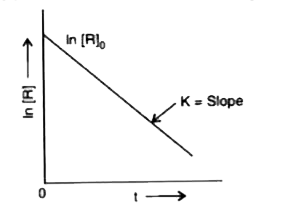A reaction is first order with respect to reactant A and second order with respect to reactant B in a reaction A+B→ product.
i) Write the differential rate equation.
ii) How is the rate of the reaction affected on increasing the concentration of B by two times? Solution in Kannada
dxdt=K[A][B]2
dxdt=K[A][2B]2
4 times
Topper's Solved these Questions
- CHEMICAL KINETICSBOOK - OSWAAL PUBLICATIONCHAPTER - CHEMICAL KINETICSEXERCISE - Topic - 1(RATE OF CHEMICAL REACTION AND FACTORS AFFECTING RATE OF REACTION ) (Long Answer Type Questions - I)
3 Videos
- CHEMICAL KINETICSBOOK - OSWAAL PUBLICATIONCHAPTER - CHEMICAL KINETICSEXERCISE - Topic - 2 (ORDER OF A REACTION , INTEGRATED RATE EQUATIONS AND HALF LIFE OF A REACTION ) (Very Short Answer Type Questions)
9 Videos
- CHEMICAL KINETICSBOOK - OSWAAL PUBLICATIONCHAPTER - CHEMICAL KINETICSEXERCISE - Topic - 2 (ORDER OF A REACTION , INTEGRATED RATE EQUATIONS AND HALF LIFE OF A REACTION )Long Answer Type Questions - II)
4 Videos
- BIOMOLECULESBOOK - OSWAAL PUBLICATIONCHAPTER - BIOMOLECULESEXERCISE - TOPIC -II (LONG ANSWER TYPE QUESTIONS)
2 Videos
- CHEMISTY IN EVERYDAY LIFEBOOK - OSWAAL PUBLICATIONCHAPTER - CHEMISTY IN EVERYDAY LIFEEXERCISE - LONG ANSWER TYPE QUESTIONS-I
1 Videos
Similar Questions
A reaction is first order in A and second order in B.
(i) Write differential rate equation.
(ii) How is rate affected when concentrated of B is tripled ?
(iii) How is rate affected when concentration of both A and B is doubled ?
View SolutionFrom the following plot, predict the order of the reaction.

View SolutionThe half-life period of a certain reaction is directly proportional to initial concentration of the reactant. Predict the order of the reaction and white the expression to calculate the half-life period of the reaction.
View SolutionWhat is α - amino acid ? Give its general structure.
View Solution(a) Why are detergents called soapless soap ?
(b) Why do soaps not work in hard water ?
View SolutionA reaction is of first order in reactant A and of second order in reactant B. How is the rate of this reaction affected when (i) the concentration of B alone is increased to three times (ii) the concentrations of A as well as B are doubled?
View SolutionA reaction is second order with respect to a reactant. How is the rate of reaction affected if the concentration of the reactant is (i) doubled (ii) reduced to half ?
View SolutionA reaction is second order with respect to a reactant. How is the rate of reaction is affected if the concentration of the reactant is i) doubled ii) reduced to half
View SolutionA reaction is first order in A and second order in B.
i) Write the differential rate equation
ii) How is the rate affected on increasing the concentrations of B there times ?
iii) How is the rate effected when the concentrations of both A and B are doubled ?
View SolutionA reaction of first order with respect to reactant A and second order with respect to reactant B. the rate law for the reaction is given by
View SolutionA reaction is of first order in reactant A and of second order in reactant B. How is the rate of this reaction affected when (i) the concentration of B alone is increased to three times (ii) the concentrations of A as well as B are doubled?
View SolutionA reaction is first order with respect to the reactant A and Second roder with respect to the reactant B in a reaction. A + B to Product. (i) Write the differential rate equation. (ii) How is rate of reaction affected on increasing the concentration of B by 2 times.
View SolutionA reaction is second order with respect to a reactant. How is the rate of reaction affected if the concentration of the reactant is (i) Doubled (ii) reduced to half ?
View SolutionA reaction is first order with respect to the reactant A and second order with respect to the reactant B in a reaction A+B→ product
Write the differential rate equation.
View SolutionA reaction is first order with respect to the reactant A and second order with respect to the reactant B in a reaction A+Bto product How is the rate of the reaction affected on increasing tile concentration of B by two times.
View Solution
